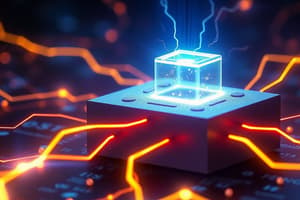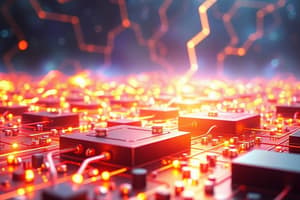Podcast
Questions and Answers
What are the two different types of material?
What are the two different types of material?
Resistance and Conductor
Why is the Semiconductor called intrinsic?
Why is the Semiconductor called intrinsic?
When no impurity is added
What is the process of adding impurities called?
What is the process of adding impurities called?
Doping
What is the conductivity of a material proportional to?
What is the conductivity of a material proportional to?
The number of free electrons in a semiconductor lies ______ to ______ electrons per cubic meter.
The number of free electrons in a semiconductor lies ______ to ______ electrons per cubic meter.
Typically, semiconductors have a forbidden energy gap of about ______ eV.
Typically, semiconductors have a forbidden energy gap of about ______ eV.
In a pure semiconductor, what is equal to the number of holes?
In a pure semiconductor, what is equal to the number of holes?
The holes and electrons move in the same direction in the field E.
The holes and electrons move in the same direction in the field E.
The total current density (J) within the intrinsic semiconductor is given by J = ______ + ______
The total current density (J) within the intrinsic semiconductor is given by J = ______ + ______
Match the following symbols with their corresponding meanings:
Match the following symbols with their corresponding meanings:
What does the symbol "n" represent?
What does the symbol "n" represent?
What is the meaning of the symbol E?
What is the meaning of the symbol E?
What is the formula for conductivity in terms of electron and hole mobility?
What is the formula for conductivity in terms of electron and hole mobility?
What is the formula for "ni" in intrinsic semiconductors?
What is the formula for "ni" in intrinsic semiconductors?
What is the formula for conductivity of semiconductor in terms of intrinsic carrier concentration and mobility?
What is the formula for conductivity of semiconductor in terms of intrinsic carrier concentration and mobility?
What is the value of mobility of free electrons in pure Germanium?
What is the value of mobility of free electrons in pure Germanium?
What is the value of mobility of holes in pure Germanium?
What is the value of mobility of holes in pure Germanium?
What is the intrinsic carrier concentration in Germanium?
What is the intrinsic carrier concentration in Germanium?
What is the value of mobility of free electrons in pure Silicon?
What is the value of mobility of free electrons in pure Silicon?
What is the value of mobility of holes in pure Silicon?
What is the value of mobility of holes in pure Silicon?
What is the intrinsic carrier concentration in Silicon?
What is the intrinsic carrier concentration in Silicon?
What is the value for intrinsic conductivity of Germanium?
What is the value for intrinsic conductivity of Germanium?
What is the value for intrinsic conductivity of Silicon?
What is the value for intrinsic conductivity of Silicon?
What is the definition of a donor impurity?
What is the definition of a donor impurity?
What is the definition of an acceptor impurity?
What is the definition of an acceptor impurity?
What is the definition of Fermi energy level?
What is the definition of Fermi energy level?
How does Fermi energy level help in separating electron and holes?
How does Fermi energy level help in separating electron and holes?
What is an energy band gap?
What is an energy band gap?
How can we differentiate insulator, semiconductor, and conductor in terms of energy band gap?
How can we differentiate insulator, semiconductor, and conductor in terms of energy band gap?
How do we prepare n-type and p-type materials from an intrinsic semiconductor?
How do we prepare n-type and p-type materials from an intrinsic semiconductor?
What are the majority carriers in n-type semiconductor?
What are the majority carriers in n-type semiconductor?
What is the most widely used semiconductor in electronic devices?
What is the most widely used semiconductor in electronic devices?
What is the energy gap between valence band and conduction band in conductors?
What is the energy gap between valence band and conduction band in conductors?
What is the range of visible light wavelength?
What is the range of visible light wavelength?
What is Plank's constant?
What is Plank's constant?
What is the speed of light?
What is the speed of light?
What is the relationship between energy and wavelength?
What is the relationship between energy and wavelength?
What is the formula for calculating energy band gap?
What is the formula for calculating energy band gap?
What is the energy band gap of a material that emits light of 400 nm wavelength?
What is the energy band gap of a material that emits light of 400 nm wavelength?
What is the definition of diffusion current?
What is the definition of diffusion current?
What is the formula for diffusion current density due to holes?
What is the formula for diffusion current density due to holes?
What is the formula for diffusion current density due to electrons?
What is the formula for diffusion current density due to electrons?
What is the definition of drift current?
What is the definition of drift current?
What is the formula for drift current density due to electrons?
What is the formula for drift current density due to electrons?
What is the formula for drift current density due to holes?
What is the formula for drift current density due to holes?
What is the formula for total current density in a semiconductor?
What is the formula for total current density in a semiconductor?
What is a PN junction diode?
What is a PN junction diode?
What is the formula for diode current?
What is the formula for diode current?
What is the formula for thermal voltage in a diode?
What is the formula for thermal voltage in a diode?
Flashcards
Resistance
Resistance
A material's opposition to the flow of electric current.
Conductor
Conductor
A material that allows electric current to flow easily.
Semiconductor
Semiconductor
A material with conductivity between that of a conductor and an insulator.
Silicon
Silicon
Signup and view all the flashcards
Intrinsic Semiconductor
Intrinsic Semiconductor
Signup and view all the flashcards
Extrinsic Semiconductor
Extrinsic Semiconductor
Signup and view all the flashcards
Doping
Doping
Signup and view all the flashcards
n-type semiconductor
n-type semiconductor
Signup and view all the flashcards
p-type semiconductor
p-type semiconductor
Signup and view all the flashcards
Thermal agitation
Thermal agitation
Signup and view all the flashcards
Recombination
Recombination
Signup and view all the flashcards
Free electron
Free electron
Signup and view all the flashcards
Hole
Hole
Signup and view all the flashcards
Mobility
Mobility
Signup and view all the flashcards
Current density
Current density
Signup and view all the flashcards
Intrinsic conductivity (σ)
Intrinsic conductivity (σ)
Signup and view all the flashcards
Donor impurities
Donor impurities
Signup and view all the flashcards
Acceptor impurities
Acceptor impurities
Signup and view all the flashcards
Energy band gap (Eg)
Energy band gap (Eg)
Signup and view all the flashcards
Insulator
Insulator
Signup and view all the flashcards
Diffusion
Diffusion
Signup and view all the flashcards
PN Junction
PN Junction
Signup and view all the flashcards
Depletion region
Depletion region
Signup and view all the flashcards
Drift current
Drift current
Signup and view all the flashcards
What is conductivity of a material proportional to?
What is conductivity of a material proportional to?
Signup and view all the flashcards
Semiconductor conductivity
Semiconductor conductivity
Signup and view all the flashcards
Forbidden energy gap (Eg)
Forbidden energy gap (Eg)
Signup and view all the flashcards
Intrinsic Silicon
Intrinsic Silicon
Signup and view all the flashcards
Extrinsic Silicon
Extrinsic Silicon
Signup and view all the flashcards
N-type impurity
N-type impurity
Signup and view all the flashcards
P-type impurity
P-type impurity
Signup and view all the flashcards
Current density (J)
Current density (J)
Signup and view all the flashcards
Donor and Acceptor impurities
Donor and Acceptor impurities
Signup and view all the flashcards
Energy band structure
Energy band structure
Signup and view all the flashcards
Forward Bias
Forward Bias
Signup and view all the flashcards
Reverse Bias
Reverse Bias
Signup and view all the flashcards
Reverse Saturation Current (Io)
Reverse Saturation Current (Io)
Signup and view all the flashcards
Forward Current (If)
Forward Current (If)
Signup and view all the flashcards
PN Junction Diode
PN Junction Diode
Signup and view all the flashcards
Study Notes
Electronic Devices
-
Different types of materials:
- Conductors: Current flows easily
- Insulators: Current cannot flow easily
- Semiconductors: Current flows with more difficulty than a conductor but easier than an insulator
-
Semiconductors:
- Conductivity is proportional to the concentration of free electrons
- Number of free electrons in a semiconductor is between 10^7 and 10^18 electrons/m^2
- Typically has a forbidden energy gap of approximately 1 eV
-
Doping:
- Adding impurities to semiconductors
- Creates extrinsic semiconductors
Conductivity of Silicon
- Intrinsic Silicon: n = p
- Mobility is a crucial element influencing conductivity
- Conductivity in a semiconductor depends on the concentration of charge carriers (holes and electrons) and their individual mobilities
Conductivity of Semiconductor
-
In a pure semiconductor, the number of holes equals the number of electrons
-
Thermal agitation continuously creates electron-hole pairs
-
Electron-hole pairs recombine
-
The total current density in an intrinsic semiconductor (J) is given by
- J = Jn + Jp, where Jn and Jp are the current densities due to electrons and holes, respectively
- Jn = q * n * μn * E, where q is the charge, n is the electron concentration, μn is the electron mobility, and E is the electric field
- Jp = q * p * μp * E, where p is the hole concentration, and μp is the hole mobility
Resistivity
- Resistivity (ρ) is the reciprocal of conductivity (σ), ρ = 1/σ
- Resistivity equation: ρ = 1/(q(n * μn + p * μp))
Donor and Acceptor impurities
- Pentavalent impurities: Donate extra electrons - n-type impurities
- Trivalent impurities: Create holes - p-type impurities
Energy Band Structures and Conduction in Insulators, Semiconductors, and Conductors
- Energy gaps differentiate these materials
- Insulators have a large energy gap (Eg > 4 eV)
- Conductors have a small energy gap (Eg < 1 eV)
- Semiconductors have an intermediate energy gap (Eg ~ 1 eV)
Drift and Diffusion
- Diffusion: Movement of particles due to a concentration gradient.
- Drift: Movement of particles due to an electric field
Questions
- Band gap: Differentiates insulators, semiconductors, and conductors
- Preparation of n-type and p-type materials: Adding impurities to intrinsic semiconductors creates n-type (extra electrons) and p-type (holes) materials
- Intrinsic conductivity: Mobility of electrons and holes impacts conductivity
- Fermi-energy level: Separates electrons and holes
- Donor/Acceptor impurities: Introduce extra electrons/holes, respectively
- Importance of band gap: Determines the material's electrical properties
Special Diodes
- Zener diode: Operates in the breakdown region for voltage regulation
- Schottky diode: Unipolar device, fast switching
Solar Cell
- Generates DC voltage - converts light energy to electrical energy
Bipolar Junction Transistor (BJT)
- Common base configuration: IE = Ic + IB
- Active region: Current amplification
- Saturation region: Current almost constant
- Cut-off region: Current very low
Field Effect Transistor (FET)
- N-channel JFET: Majority carriers are electrons
- P-channel JFET: Majority carriers are holes
- Types of FETs: JFET, MOSFET
- FET operation: Controlled by an electric field
Studying That Suits You
Use AI to generate personalized quizzes and flashcards to suit your learning preferences.




